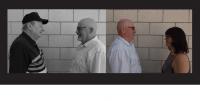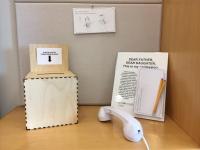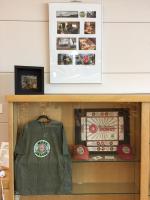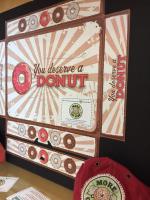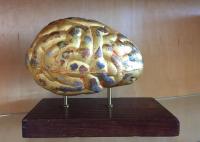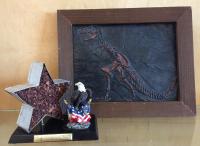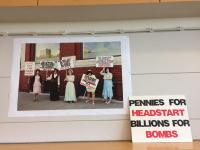For m.o.i. aka Minister of Information and Sarah Star Wilkison, message precedes the medium. Similar to storytellers, the father-daughter duo are interested foremost in the narrative of their ongoing exploration to make sense of the world we live. Whether it is bringing awareness of women engaged in occupations primarily associated with men through photographs (m.o.i.’s series Work and Progress) or shedding light on the continuation of inequalities through a historicized performance (Sarah Star’s Remember the Ladies), these artists employ a breadth of mediums dependent on the content and context for which the work is intended to reside.
Perplexed by the notion of food deserts and people living below the poverty line in one of America's wealthiest counties in the country – Johnson County; the artists chose a 1950s Airstream trailer filled with ephemeral, didactics, graphs, photos, and actual food as their medium for their project More or Le$$. Referencing the start of the Library in the 1950s with a contemporary of its time, the Airstream trailer played to the nostalgia of many viewers and transported them to a happier, simpler time. Only upon entering the trailer were viewers confronted with issues of poverty and its correlation to access (or lack thereof) to healthy food in the county.
Their latest collaboration, Dear Father, Dear Daughter: This is my confession… addresses universal narratives through the public participation of sharing, anonymously, their personal confessions. The public provided responses to the artists’ directive “Dear Father/Daughter, This is my confession/question:” in writing. The artists then recorded themselves reading the responses and dialoguing about those responses; acting as though they were the owner of that confession. m.o.i. explains this best by stating, “For this work, we wanted to get at how people use their own voice but then try to discover some universality in what they bring to the surface by reinventing those narratives in a new way. And hopefully, as artists we are learning new things about not just the relationships of others but also our relationship to each other. As father to daughter. And vice versa.”
To understand each their practices more, we asked each a series of questions. The following are their responses:
What comes first – the medium or the message?
m.o.i.: I’m interested foremost in the narrative and marvel at the breath and scope of how artists practice storytelling. For this work, we wanted to get at how people use their own voice but then try to discover some universality in what they bring to the surface by reinventing those narratives in a new way. And hopefully, as artists we are learning new things about not just the relationships of others but also our relationship to each other. As father to daughter. And vice versa.
Sarah Star: Definitely the message. The work here has elements of drawing, sculpture, and photography of performance. Generally I'll go through a few different mediums on one piece until I find the one that conveys the message I want to convey. Be A Citizen for instance, started as a painted certificate that would be given out, then transformed to a large gold cup award, then eventually became a hand sculpted clay medal on a ribbon.
What do you feel is your role as an artist?
Sarah Star: My goal is always to pose a question or open a dialogue. As a hairstylist, I'm often in charge of directing conversations with people. In my artwork, I'm opening up dialogues often about subjects that are sensitive or divisive. I'm not one to engage in a heated conversation about politics with someone, but I am very opinionated, so I make work reflecting how that conversation might go. I'm always examining what makes someone an activist and I feel that the work that I do is my piece in the activism puzzle.
m.o.i.: I’m not sure it’s much different that the role of anyone else as long as they are comfortable pushing themselves to keep learning, exploring, and trying to make sense of the world. For me, one key to art making is being uncomfortable with the world. And because of that, we strive to reinterpret, to make sense of it. For ourselves. And for others.
What influences your practice/works?
m.o.i.: Early on I was exposed to theater, somewhat surprising, since I grew up in a small, rural town but seeing the works of Arthur Miller and Tennessee Williams brought to life on stage enamored me with the struggles and quiet triumphs we all undergo. Music, especially gospel, soul, and punk. Later I discovered the Fluxus Art Movement and the freedom to make art from anything, with no boundaries, and that was incredibly liberating. I’ve also worked a lot of different jobs over the years: baker, clerk, laborer, and scientist to name a few and am fascinated by how our toils shape our view of the world.
Sarah Star: Current events. Politics, news, the relationships I have with the people around me.
Who are the other artists you look to for inspiration? and what about their works do you like?
Sarah Star: I could name off certain artists whom's works I like more than others, but I'm influenced mostly by the art that is all around me. I try to find a message in all the art and design that surrounds our society. That certainly includes visual art and sculpture in museums, but I get my best inspiration looking at things people might forget are made by artists. Food packaging, billboards, magazine ads, architecture, movie soundtracks, television commercials, fashion. Because my art is generally touching on current events, I feel like this "everyday" artwork is what will guide me to make work that fits in with the times and message I'm trying to convey.
m.o.i.: Elvis Costello has always been a big inspiration, primarily because he’s never been one to keep his practice static. Same with David Byrne. Even when playing songs from their oeuvre, they are always messing with the arrangements to keep things fresh. I love the circuitous nature of Art Spiegelman’s and Laurie Anderson’s storytelling; how the story threads expand outward but eventually wraps back to a conclusion. It’s that journey of discovery along the way that makes art so inviting.
What other writings do you recommend reading to have a better understanding of your artworks and your art practice/process?
m.o.i. recommendations:
Maira Kalman, And the Pursuit of Happiness
All of Us or None of US, Social Justice Posters of the San Francisco Bay Area
Spalding Gray, Swimming to Cambodia
George Orwell, All Art is Propaganda, critical essays compiled by George Packer.
Sarah Star: I can’t really say that I can think of books that I would recommend to better understand my practice, however, there are books that I read while creating the works; books that helped me narrow my focus. I don’t suppose they really make sense all in a list, but that’s kind of like me!
Seneca Falls and the Origins of the Womens Rights Movement
For more information on m.o.i., visit him on the Web, Social Media or Flckr.
For more information on Sarah Star, contact the artist at swilkison@hotmail.com.

